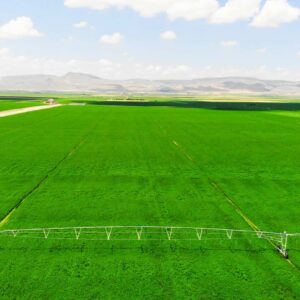Solar-Powered Irrigation Systems and Their Role in Sustainable Agriculture
Today, with the increasing global population, food demand, agricultural production, the use of new techniques and technologies, and energy needs are all rising in parallel. Natural disasters such as floods, storms, and droughts contribute to a decrease in agricultural products. In recent years, renewable energy sources such as solar, wind, geothermal, and wave energy have been increasingly used to meet the world’s growing energy needs.
The increase in agricultural productivity is closely tied to the economic and correct use of limited resources such as soil and water. In areas where direct access to water is unavailable for regular irrigation, or in cases where pressurized irrigation systems are used (where gravity cannot be utilized), additional energy sources are required to deliver water to plants, typically sourced from canals, rivers, reservoirs, or groundwater.
The most suitable solution to meet these energy requirements is to power irrigation pumps using electricity generated from solar energy, as an alternative to diesel or electric pumps. Solar-powered irrigation systems make the process more cost-effective, especially as the cost of fuel and rising electricity bills make solar energy an increasingly attractive option.
In particularly arid regions, where solar exposure and energy availability are sufficient, utilizing solar energy to pump groundwater for irrigation is one of the best solutions.
How Solar-Powered Irrigation Systems Work
In solar-powered agricultural irrigation systems, the pumps used to transfer water from the source to the plants are powered by electricity. This electricity is generated by solar panels, which convert sunlight into electrical energy. Due to the high initial investment costs, it is important to size the system correctly. It is necessary to calculate or estimate the total height from which water will be pumped, the daily water requirements, and the average solar energy available in the region beforehand.
Main Components of Solar-Powered Irrigation Systems
Solar-powered irrigation systems consist of three main components:
- Pump Motor (surface water pump, submersible pump),
- Pump Driver (if the pump motor works with an AC inverter / Variable Frequency Drive (VFD) for DC-powered motors),
- Solar Panels to generate electricity.
The system is designed to match the power of the existing surface water pump or submersible pump in the field, and the number of panels and the pump driver (control panel) are determined accordingly. When installing the panels, they must be positioned at an angle facing south and designed to avoid shading. Afterward, steel supports are driven into the ground or mounted on concrete to create the necessary infrastructure for the panels. Since the panels are durable, attention must be given to their longevity.
Flexibility and Durability of the System
Solar-powered irrigation systems can be designed as portable systems or with single-axis solar tracking. Once the panels are installed, electrical connections are made, and an appropriate panel will generate either monophase or trifase alternating current, depending on the needs of the pump. The pump is then connected to the panel, and the system is ready for use.
Regular checks and cleaning of cables and connections will help extend the lifespan of the system.
Advantages of Solar-Powered Irrigation Systems
Solar-powered irrigation systems offer several benefits, including:
- Enabling irrigation in areas far from the electrical grid.
- Easy system installation and minimal maintenance requirements.
- Long lifespan, typically paying for itself in 5-6 years.
- Environmentally friendly, as it does not require fuel and has near-zero CO2 emissions.
- Using renewable solar energy as the energy source.
- High efficiency and low electrical losses.
- Independence from fluctuating electricity or fuel prices.
- Although the initial investment is high, the operating costs are low, and the system provides a fast return on investment.
Due to these advantages, there is an increasing demand for solar-powered irrigation systems. When the energy needs are met by integrating solar panels into the system, the efficiency, energy, water consumption, and cost savings further highlight the benefits of solar-powered center pivot and linear irrigation systems.
Cost Efficiency and Long-Term Benefits
The installation costs of solar-powered systems may appear high at first, but thanks to the efficient use of energy, water, and soil resources, the investment can be recouped in just a few years. Afterward, the systems can last for a minimum of 20-25 years, which adds to their advantages.
Solar panels generate energy from the early hours of the morning until sunset, with peak energy production occurring around midday. In irrigation applications, the timing aligns well with the plants’ highest water needs, making the system more effective during these hours. These systems continue to work even on cloudy days, though water efficiency may decrease. To overcome this, the most economical and reliable solution is to install a large water reservoir. Excess water collected during sunny periods can be stored in the reservoir for use during nighttime or on cloudy days, reducing the need for external energy sources. In rainy weather, the system does not need to operate, making it highly environmentally compatible.
Atlantis Solar-Powered Irrigation Systems
Atlantis uses some of the world’s most modern computer-assisted technologies for irrigation, including rotating or linear motion-based center pivot and linear irrigation systems. These systems work under low pressure, reducing the energy needed for operation. When solar panels are integrated into the system, the efficiency, energy consumption, water usage, and cost savings further highlight the benefits of using solar-powered center pivot and linear systems.
While the initial installation costs may be high, the efficient use of energy, water, and soil resources allows the investment to be recovered in a few years. The long lifespan of the systems, typically 20-25 years, adds significant value. Atlantis is committed to optimizing efficiency at low costs while prioritizing environmental sustainability. By using solar energy, a completely clean and renewable resource, Atlantis ensures that the irrigation process is powered in an eco-friendly manner.


cheap androxal purchase from canada
androxal on line cash on delivery
levitra benefits over enclomiphene
purchase enclomiphene united kingdom
cheapest buy rifaximin lowest price viagra
ordering rifaximin generic overnight delivery
how to buy xifaxan buy japan
how to buy xifaxan cheap fast shipping
buy cheap staxyn generic does it work
buy staxyn uk cheapest
cheapest buy avodart buy san francisco
canadian pharmacy online avodart
buying dutasteride canada on sale
get dutasteride cheap canada pharmacy
order flexeril cyclobenzaprine how to purchase viagra
buy cheap flexeril cyclobenzaprine generic does it works
cheapest usa gabapentin
buy cheap gabapentin generic switzerland
get fildena generic when will be available
get fildena lowest cost pharmacy
cheap itraconazole uk buy over counter
buy itraconazole cheap prices
comprar kamagra originál
kde koupit kamagra singapore
réduction en ligne kamagra
kamagra generico en ligne